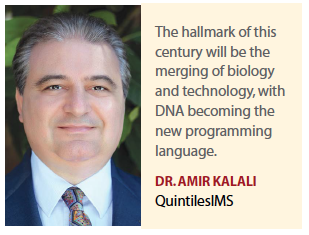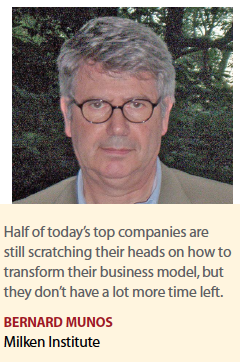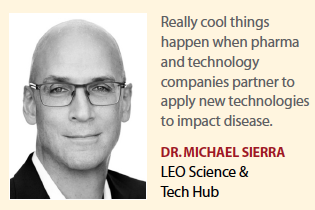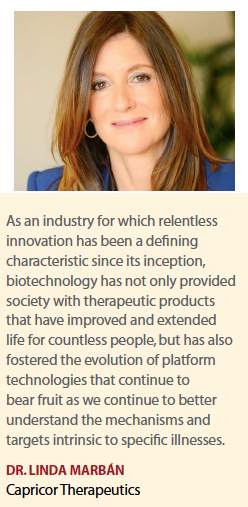Most disruptive technology initiatives are taking place in smaller, more agile companies, and in the clinical trial phase of development, but even big companies such as Pfizer and GSK are testing the possibilities of artificial intelligence, blockchain, and especially mobile and other transformative clinical tools.
When speaking of this new environment, Bernard Munos doesn’t like to use the word disruption, because it scares people. He  prefers the word transformation in describing the changes taking place in the industry. Mr. Munos, senior fellow at FasterCures, Milken Institute, says disruption is happening because the industry’s business model has aged to the point where resources — time and money — are being squandered in vast amounts.
prefers the word transformation in describing the changes taking place in the industry. Mr. Munos, senior fellow at FasterCures, Milken Institute, says disruption is happening because the industry’s business model has aged to the point where resources — time and money — are being squandered in vast amounts.
“So, the industry is going to have to undergo a transformation," he says. “I prefer to use that term rather than disruption, because I find disruption spooks people."
Dr. Amir Kalali, head, neuroscience center of excellence, QuintilesIMS, also does not use the term disruption. He finds that in the risk-adverse pharma industry, it is not a useful term and can actually be a barrier to adoption of new technology. “Nobody wants to be ‘disrupted,’ " he says.
While disruption — or transformation — happens about every 30 years or so across all industries, companies still seem to get caught off guard. “I find this really fascinating because they have everything that they need in order to avoid the disruption," Mr. Munos says, speaking specifically about pharma. “Pharma companies have lots of money, lots of smart people, and they’ve got a lot of staying power — they know their market, they know their customers, and they have technological expertise. But  they are so caught up in the traditional model’s inefficiencies, making transformation very painful."
they are so caught up in the traditional model’s inefficiencies, making transformation very painful."
However, there are pharma companies that have begun to adapt to meet the pressures of developing drugs in today’s market, and a couple of new business models are emerging as a result of the transformation.
The first is the traditional pharma model with the addition of “hyper-innovation."
“Companies such as J&J and GSK, for example, and Novartis to some extent, have stuck to the traditional big pharma model, but they have embraced innovation to increase their output, which I call hyper innovation, which is yielding close to two new drugs per year," Mr. Munos says. “If a company has that level of output, it generates enough cash to cover the significant structural costs that the big pharma model implies."
The second model is the specialty bio-pharma model, which is exemplified by companies such as Bristol-Myers Squibb, which used to be considered a big pharma company, but has redesigned itself into a specialty biopharma company, Mr. Munos says. BMS shed all the assets in which it was not world-class, selling them to other companies, and reinvesting the money in breakthrough science.
Companies that fall in between the two models may face extinction, Mr. Munos says, adding that if they want to survive they will have to decide which transformative model works best for them.
 “If they want to stick with a big pharma model, that’s fine, but they have to start adopting hyper innovation, and not all companies are capable of doing that," he says. “If they don’t think they can adopt hyper innovation, then they have to transform into a specialty biopharma company if they want to survive."
“If they want to stick with a big pharma model, that’s fine, but they have to start adopting hyper innovation, and not all companies are capable of doing that," he says. “If they don’t think they can adopt hyper innovation, then they have to transform into a specialty biopharma company if they want to survive."
Mr. Munos estimates that about half of the top 22 pharmaceutical companies are well on their way to a successful transformation, but the other half have not embraced the technology disruption occurring around them.
“Many of today’s companies are still scratching their heads and wondering which way they’re going to go, but they don’t really have a lot more time to decide," he says. “They’re going to have to make a decision because billions of R&D dollars are being spent every year, and if they are not producing adequate returns, something is going to break, sooner or later."
According to Dr. Kalali, every aspect of the industry can be improved by new technology. “The ones I will call out are synthetic biology, artificial intelligence, ambient biosensors, robotics, 3D printing, and technologies enabling deeper engagement with patients," he says. “The hallmark of this century will be the merging of biology and technology with DNA becoming the new programming language."
One biotech company that is embracing such a merger is Capricor Therapeutics, which has been built around a cardiac cell-based therapy that is showing signs of promise in certain cardiovascular disease settings.
“As an industry for which relentless innovation has been a defining characteristic since its inception, biotechnology has not only provided society with therapeutic products that have improved and extended life for countless people, but has also fostered the evolution of platform technologies that continue to bear fruit as we continue to better understand the mechanisms and targets intrinsic to specific illnesses," says Linda Marbán, Ph.D., CEO, Capricor Therapeutics. “A relatively recent and exciting development is the realization that our cells exert their effects through nano-sized bubbles that they secrete, which get taken up into the cells of organs in the host. These exosomes, as they are termed, are chock full of bioactive molecules that have long-lasting effects on how their target cells express their own genes, which in turn can sustainably alter their functions. Not only are the exosomes able to reproduce the effects of our cells in cardiac disease models, but they are also able generate profound effects in other disease settings such as those of the eye and skin. And, in contrast to cell-based products, exosomes can be handled much like traditional biopharmaceuticals such as recombinant proteins and monoclonal antibodies."
Capricor is one of several companies that is investing heavily in the field of exosome science, powered by the growing belief that these tiny particles, which had once been thought to serve merely in the disposal of cellular waste, are a “disruptive" platform technology that have the potential to generate a new class of medicines in the not-too-distant future.
Tech Driving Transformation
Whether you call it disruption or transformation, there is evidence that the industry has certainly started adopting new processes in response to the new technology environment, including AI, blockchain, and especially mobile data capturing mechanisms that improve clinic response times. These tools can help cut costs by streamlining processes so more can be done efficiently and faster, including failing.
Failing faster is important these days in terms of moving science along — or not — and keeping costs down through the discovery and development phases.
“Most of what we do in research will fail," says Michael Sierra, Ph.D.,VP, LEO Science & Tech Hub. “The issue is most companies are built to push as hard as possible. As a scientist, you give me good data or bad data, and I can always provide a reason why we should go on. It may not be the rig ht reason, but it is a reason. That’s what we do."
ht reason, but it is a reason. That’s what we do."
Using new tools can improve predicting, diagnosing, and monitoring disease, as well as help the company make better go or no-go decisions.
LEO is hoping to harness the power of artificial intelligence and cloud computing to assist in its endeavors to help patients and doctors to diagnose, monitor, and treat skin diseases more effectively. For example, patients could use their iPhone to send a photo of their skin condition to a cloud data platform that quickly analyzes it using AI. Another goal for the company is to help patients avoid skin biopsies by using a picture of the skin and with the help of advanced data analysis, a physician can prescribe the right treatment without needing to perform surgery.
“We’re looking at imaging, biomarkers, and noninvasive skin testing and tying it all together with AI/cognitive computer learning," Dr. Sierra says. “Usually, when we’re looking at data, we’re only looking at things that we can visually see. Having the computer to be able to learn, we can find correlations that would not have been seen with the human eye."
Dr. Sierra believes that collaboration is key in using technology to determine the viability of a new product or process.
Transformation requires new skill sets that are not always available in-house, and it would be extremely difficult to build all that was required from within a company, especially in the fast-paced technology revolution.
“It is difficult to build all the competencies in-house as quickly as the world is evolving, especially if we start thinking about all the digital technologies and innovations that are emerging," he says. “It’s just impossible to build all the competencies necessary internally and execute on them."
However, when pharma companies partner with cutting-edge technology companies, Dr. Sierra says, this is where really cool things happen.
“New technologies when applied in the clinic setting or with devices can really impact predictability of disease, facilitate the diagnosis of disease, and help patients better understand and monitor their disease," he says.
 In large companies such as Pfizer, there may be many skill sets available in-house, but in some cases even they may need to bring new hires on board who have different and new expertise.
In large companies such as Pfizer, there may be many skill sets available in-house, but in some cases even they may need to bring new hires on board who have different and new expertise.
Craig Lipset, head of clinical innovation, global product development, Pfizer, says his company has invested significantly in making sure that it has the right clinicians, technologists, and engineers to execute around its innovative platforms, such as Blue Sky, its AI cognitive computing-driven program in Parkinson’s. He says bringing the right talent together creates more diverse teams in terms of new skills, roles, and thinking.
“Our digital and AI projects required us to create some new roles, including unique crossovers of engineers and clinicians," he says. “We are making sure we have places where engineers and clinicians can work side by side in collaborative ways. We have young, digitally savvy clinicians, as well as more senior clinicians who are very savvy around the drug development process. We have an interesting opportunity to bring that diversity together as we’re looking at these new tools. I’m not sure that any one phenotype of an individual has all the right skills and competencies today to manage everything we want to achieve." (PV)



















